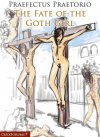@Baracus has raised an interesting point. Why does a modern cultural-fashion phenomenon carry the same name as a Germanic Tribe from the 4th Century? Believe it or not, there is a connection. However, it is a long and meandering connection.
On 24 August 410 AD, just 27 years after our story, the City of Rome was sacked by the Visigoths led by their king, Alaric. At that time, Rome was no longer the Western Roman Empire's capital, having been replaced in that position first by Mediolanum in 286 and then by Trier and finally Ravenna in 402. Nevertheless, Rome's city retained a central position as "the eternal city" and the spiritual center of the Empire. The sack was a major shock to contemporaries, friends, and foes of the Empire alike. Many Romans saw it as punishment for abandoning traditional Roman religion for Christianity. In response to these accusations, and to console Christians, Saint Augustine wrote his most significant work,
De civitate Dei contra paganos (The City of God against the pagans), as an argument for the truth of Christianity over competing religions and philosophies.
The end of the "civilized" Republic and Empire (some would argue that the Roman punishments seen in this story sully the word civilized when applied to Roman) at the hands of the "barbarian" Goths was remembered as a significant turning point in European history. And the Goths attained a lasting reputation (probably undeserved) as enemies of high culture (second only to their fellow East Germans, The Vandals). From this point onward, most rulers in the West were the new Germanic tribes and not the old Italian aristocracy. The Goths were succeeded by the Franks and the whole period of cultural and economic decline became known later as “The Dark Ages.”
Skip ahead to the completion in Paris of
Basilique royale de Saint-Denis. The building is of singular importance historically and architecturally as its choir, completed in 1144, was one of the first structures to employ all of a new architectural style elements. Eschewing the Greco-Roman classical styles of solid walls and round arches and columns, the defining design element of Gothic architecture is the pointed or ogival arch. The pointed arch's use, in turn, led to the development of the pointed rib vault and flying buttresses, combined with elaborate tracery and stained glass windows. At the time, the new style was known as
opus Francigenum (French work).
Four hundred years later came the Renaissance, by those ambitious to revive the Grecio-Roman orders of architecture and art. These men were contemptuous of the
opus Francigenum and derisively named it “Gothic” as belonging to the Barbarian Dark ages. The pervasive influence of the Renaissance on later intellectual thought fixed this name in place. However, the twin heritages of restrained Classical antiquity and Medieval emotional exuberance continued to vie for supremacy through the ages. Successive waves of art, music, and architecture reflected this tension in the Baroque, Rococo, Classical and Romantic periods.
In the Romantic period, a new kind of literature arose that rejected the carefully scripted and controlled forms of the Classical/Enlightenment period with a darker, more emotional cast. It was generally believed to have derived from the English author Horace Walpole's 1764 novel
The Castle of Otranto, the new genre covered horror, death, and romance. Walpole, himself, later subtitled his book, "A Gothic Story," harkening back to Gothic architecture and a fascination with the untamed barbarian past. This movement looked to the primitive spirits of nature and the dark forces in the depths of the forest for inspiration. Jane Austin, in her first novel, Northanger Abbey, satirizes her youthful infatuation with Gothic.
The label Gothic stuck with literature and later movies up until the 1970s. Then British, post-punk groups like Joy Division, Bauhaus, and The Cure combined punk dissonance with gloomy lyrics inspired by the Victorian era and classic Gothic horror. By the early 80s, such bands were described by the press as Gothic Rock. The name now applies not only to the music but also to the fashion and lifestyles associated with it.
While our Barbara dislikes tattoos and piercing, this history shows that she can honestly be called the original “Goth Girl.”
Ok. How many here
(besides Eul) knew that?









